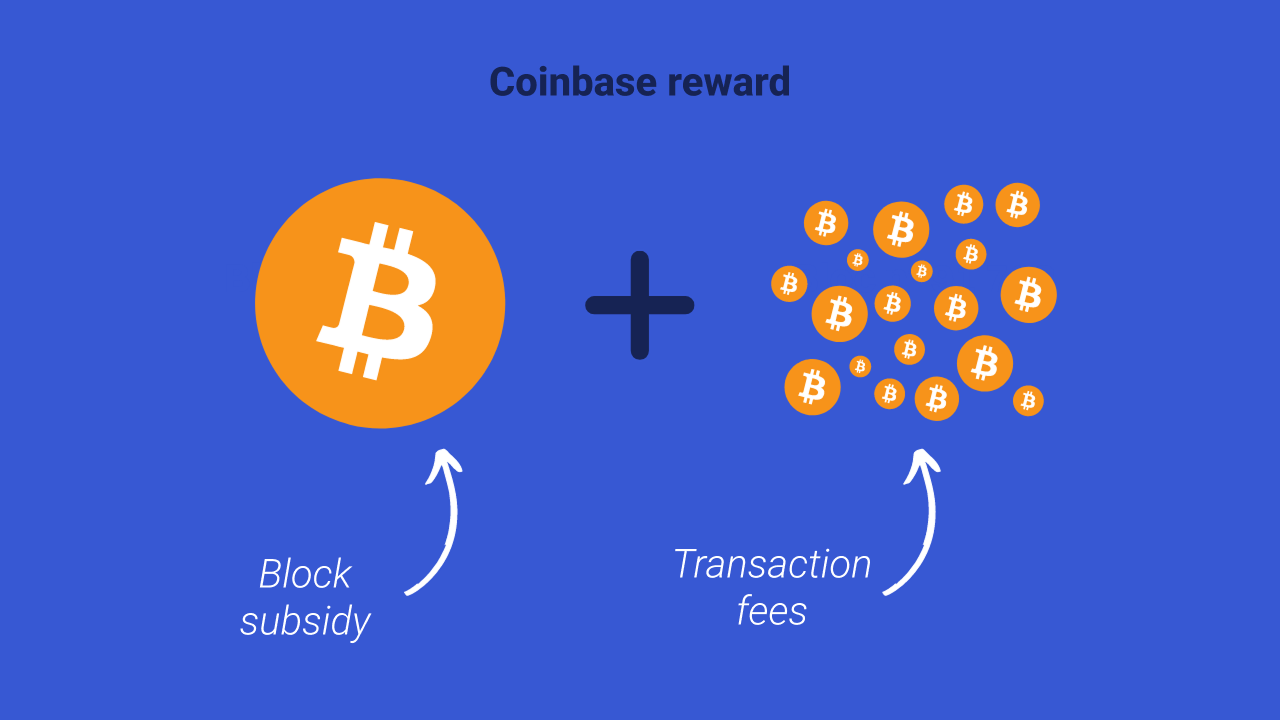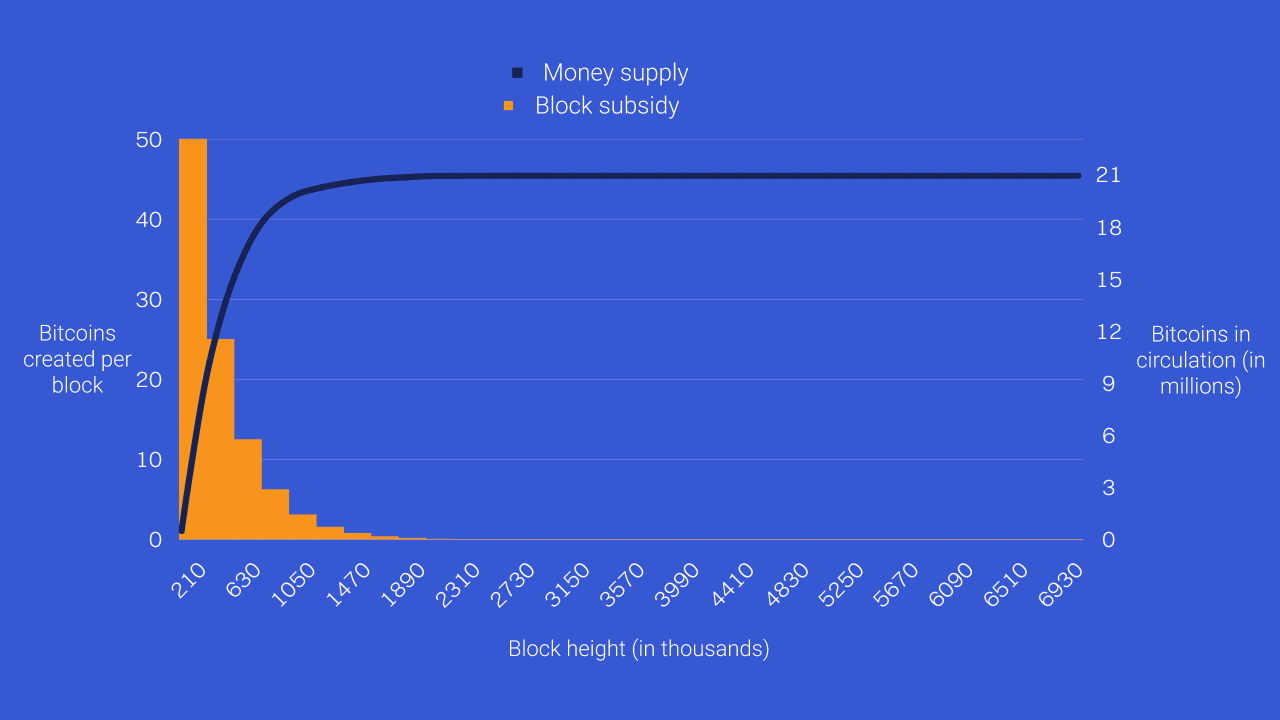Get started
Get started

The term halving (“division by two” in French) refers to a scheduled event that halves the grant awarded to miners for each block produced on Bitcoin.
In this article, we explain everything you need to know about halving, the Coinbase reward, and the distribution mechanism for the famous 21 million bitcoins.
Mining is an essential device for the proper functioning of the Bitcoin protocol. What is called “mining” is the action of participating in the Proof-of-Work mechanism.
As a reminder, on Bitcoin, a timestamp register is used to keep transaction history. This is what you also know as “Blockchain.” Thanks to this decentralized register, each user can verify that there is no double spending of bitcoins, without the need to use a trusted third party.
However, a way must also be found for all users to agree on a single registry for the entire network. By having a single register for everyone, you can answer the question: “Who owns what? ”. This means is the principle of the Nakamoto consensus. It specifies that the blockchain with the largest amount of accumulated work should be considered to be the unique version of the Bitcoin ledger. In this consensus principle, proof of work is simply a mechanism to resist Sybil attacks. It makes it possible to establish a cost for multiplying votes. In other words, to be able to create a block on Bitcoin, miners have to do some work. In this way, changing the blockchain in the past is made physically difficult.
This work is simply computer calculation. Miners must try a multitude of combinations for their block, in order to find a footprint that is smaller than the target set by the network. The first miner who finds a block that meets this condition wins the right to add it to the blockchain.

➤ Learn more about how proof of work (PoW) works.
Since mining requires calculations, it involves the use of energy and processor time. All of this represents a financial cost for the minor. You must therefore be able to pay each person who produces a valid block in order to create an incentive to remain honest. That's the primary purpose of the Coinbase Reward.
This monetary reward is distributed to the miner who produces a valid block through a specific transaction, called a “coinbase transaction”, composed of two parts:

The block grant is simply a monetary creation. The winning miner has the right to produce a defined number of bitcoins ex nihilo. This is how bitcoins are gradually issued on the system.
Transaction fees, on the other hand, represent the sum of the fees allocated to each transaction included in the block. As a reminder, the fees of a Bitcoin transaction are calculated by making the difference between the total inputs and the total outputs.
As you know, the total issuance of bitcoin is limited to 21 million units. Once this ceiling is reached through the block grant, the remuneration of miners will be based exclusively on transaction fees. To ensure a smooth transition, this grant is gradually reduced over time.
.png)
Thus, when Bitcoin was launched in January 2009, miners were allowed to create 50 bitcoins for each block. Every 210,000 blocks (i.e. approximately every 4 years), this subsidy is halved. In this way, we can gradually smooth the transition to fee-based remuneration, while ensuring fair monetary distribution.
The term “halving” refers to this scheduled event that halves the reward given to miners for each block mined. Every 210,000 blocks, we say there is a “halving.”
Halvings will continue to happen until the block grant reaches zero, at which point the maximum supply of 21 million bitcoin will have been reached. This will take place around the year 2140.

In reality, we will never fully reach this 21 million limit. The maximum emission will be slightly lower than this number, and this is due to several factors. I will tell you about this in detail in a future article.
The grant for each mined block was initially 50 units at the launch of Bitcoin. Every 210,000 blocks, there is a new halving:
The next halving will happen at block 840,000. If we make a forecast based on current data, this event should happen in April or May 2024. At that point, the block reward will be reduced from 6.25 to 3.125 bitcoins. This will be the fourth halving in Bitcoin history.
As written Ludovic Lars, the 21 million limit was chosen mainly for two reasons. First, Satoshi determined a number to make bitcoin prices similar to those of existing currencies. The sub-divisions into SATS (1 BTC = 100 million SATS) allow the Bitcoin unit of account to be suitable for any eventuality. If the value of Bitcoin explodes, we will prefer to use the smallest unit. On the other hand, if it remains a niche currency, we can always use larger units.
It is therefore likely that Nakamoto was inspired by the total money supply in circulation at the end of 2008, which was around 20 trillion US dollars, all currencies combined. When you consider the divisions, you get about the same number of cents in circulation in 2008 as there are sats in circulation on Bitcoin.
The second reason that would have led Satoshi to adopt this number is the mechanism of halvings. Indeed, the number of 21 million makes it possible to opt for an interval between each halving that is easy to remember (210,000 blocks). When you calculate the time taken by the 210,000 blocks to be mined, you get a duration close to 4 years.
➤ Find out why the block interval is 10 minutes on Bitcoin.
Before reaching the end of the block grant, it will be further reduced at each halving. We will gradually move from a system of remuneration for minors established on monetary issuance, to a system of remuneration established on a fee market. The question to be asked would therefore be: will there be a sufficient fee market to ensure the security of the Bitcoin protocol over the course of halvings?
Obviously, this question is difficult to answer. This will necessarily depend on the adoption of Bitcoin as a currency, and on the behavior of its users. But, in any case, Bitcoin will have the security it deserves. If a lot of people use it, there is bound to be a high demand for block space. The transaction fees will then be very high, and the security of the system will be consistent with the number of people using it. Conversely, if Bitcoin becomes a tool used on the sidelines by a few cypherpunks and libertarians, then the demand for block space will be lower, and so will the transaction fees. The security of the system will necessarily be lower, but since it is only used by a few users, this will be consistent.
Other cryptocurrency systems such as Monero then opted for what is called perpetual issuance. The idea is to guarantee the miner a minimum remuneration of 0.6 XMR for each mined block. Within Bitcoin itself, some renowned developers such as Peter Todd would like us to be able to think of a similar solution. This would mean removing the total 21 million limit.
In reality, this question of the remuneration of minors is extremely complex. It even goes beyond the technical framework of Bitcoin since it involves concepts that are almost political and economic. Indeed, it is important to understand that the remuneration of miners depends either on the issuance of new coins or on transaction fees. If we choose a perpetual issuance system, we make the financing of minors rely on savers by diluting the value of each unit of currency. This is the system we are currently in, on an ephemeral basis, since 6.25 BTC are issued ex nihilo every 10 minutes.
On the contrary, if one chooses a fee-based market system, then one makes the funding of minors rely on the users who transact. If nothing is changed in the Bitcoin code, it will be on this system that it will rely 100% on when the last halving occurs.
In any case, no solution is magic. Bitcoin's security will necessarily depend on its number of users.
Historically, halvings have always preceded a period of sharp rise in the price of Bitcoin. Indeed, the first peak of Bitcoin price took place in November 2013, just one year after the first halving. The second peak occurred in December 2017, just over a year after the second halving. And the current all-time high (ATH) for bitcoin, which occurred on November 8, 2021, at $67,500, came 18 months after the 2020 halving.

This phenomenon is in part due to the sudden fall in money production. As soon as a block is mined, the 6.25 bitcoins produced dilute the value of all the other units in circulation. Imagine that right now, every 10 minutes, the production of new bitcoins puts downward pressure on the purchasing power of the asset. When a halving occurs, this pressure is halved.
With each halving, fewer bitcoins are produced every 10 minutes. As a result, the dilution of the value of the units in circulation is suddenly less strong, and so is the downward pressure. If the demand for Bitcoin remains constant, and its supply stabilizes, then its price increases.
Obviously, past observations cannot in any way prejudge the future results of the Bitcoin price.
➤ Discover how the price of Bitcoin is determined.
The Bitcoin halving is an event scheduled every 210,000 blocks (about 4 years) that halves the subsidy offered to miners for each block. This principle makes it possible to ensure the gradual distribution of bitcoins until reaching the ceiling of 21 million units in circulation.
Once this limit is reached, the remuneration of minors will depend exclusively on transaction fees.




